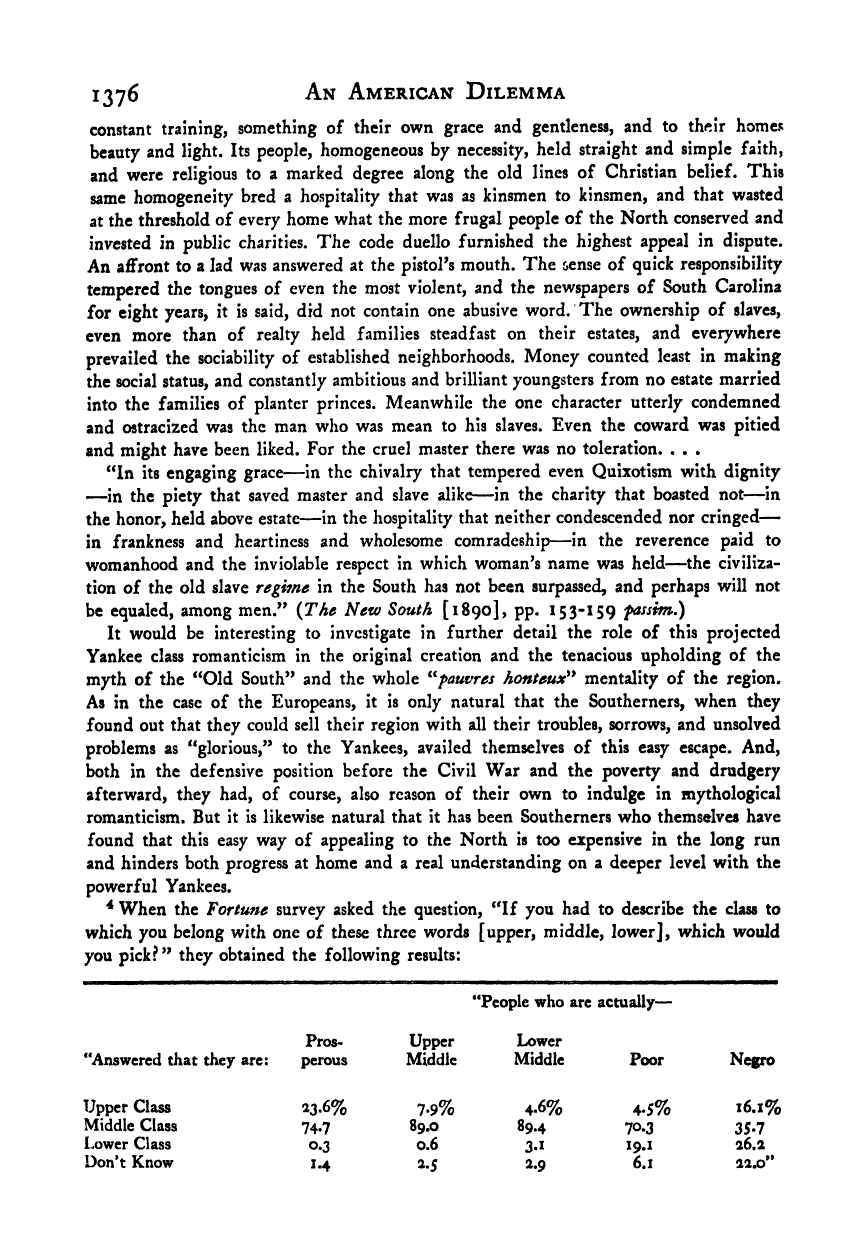Note: Gunnar Myrdal died in 1987, less than 70 years ago. Therefore, this work is protected by copyright, restricting your legal rights to reproduce it. However, you are welcome to view it on screen, as you do now. Read more about copyright.
Full resolution (TIFF) - On this page / på denna sida - Footnotes - Chapter 31

<< prev. page << föreg. sida << >> nästa sida >> next page >>
Below is the raw OCR text
from the above scanned image.
Do you see an error? Proofread the page now!
Här nedan syns maskintolkade texten från faksimilbilden ovan.
Ser du något fel? Korrekturläs sidan nu!
This page has never been proofread. / Denna sida har aldrig korrekturlästs.
1376 An American Dilemma
constant training, something of their own grace and gentleness, and to their homes
beauty and light. Its people, homogeneous by necessity, held straight and simple faith,
and were religious to a marked degree along the old lines of Christian belief. This
same homogeneity bred a hospitality that was as kinsmen to kinsmen, and that wasted
at the threshold of every home what the more frugal people of the North conserved and
invested in public charities. The code duello furnished the highest appeal in dispute.
An affront to a lad was answered at the pistol’s mouth. The sense of quick responsibility
tempered the tongues of even the most violent, and the newspapers of South Carolina
for eight years, it is said, did not contain one abusive word. The ownership of slaves,
even more than of realty held families steadfast on their estates, and everywhere
prevailed the sociability of established neighborhoods. Money counted least in making
the social status, and constantly ambitious and brilliant youngsters from no estate married
into the families of planter princes. Meanwhile the one character utterly condemned
and ostracized was the man who was mean to his slaves. Even the coward was pitied
and might have been liked. For the cruel master there was no toleration. . . .
“In its engaging grace—in the chivalry that tempered even Quixotism with dignity
—in the piety that saved master and slave alike—in the charity that boasted not—in
the honor, held above estate—in the hospitality that neither condescended nor cringed
in frankness and heartiness and wholesome comradeship—in the reverence paid to
womanhood and the inviolable respect in which woman’s name was held—the civiliza-
tion of the old slave regime in the South has not been surpassed, and perhaps will not
be equaled, among men.” {The New South [1890], pp. 153-159 fassim.)
It would be interesting to investigate in further detail the role of this projected
Yankee class romanticism in the original creation and the tenacious upholding of the
myth of the “Old South” and the whole *‘^fauvres honteux*^ mentality of the region.
As in the case of the Europeans, it is only natural that the Southerners, when they
found out that they could sell their region with all their troubles, sorrows, and unsolved
problems as “glorious,” to the Yankees, availed themselves of this easy escape. And,
both in the defensive position before the Civil War and the poverty and drudgery
afterward, they had, of course, also reason of their own to indulge in mythological
romanticism. But it is likewise natural that it has been Southerners who themselves have
found that this easy way of appealing to the North is too expensive in the long run
and hinders both progress at home and a real understanding on a deeper level with the
powerful Yankees.
^ When the Fortune survey asked the question, “If you had to describe the class to
which you belong with one of these three words [upper, middle, lower], which would
you pick?” they obtained the following results:
“People who arc actually
“Answered that they arc;
Pros-
perous
Upper
Middle
Lower
Middle Poor Negro
Upper Class 23- 6% 7-
9% 4.6% 4-5% 16.1%
Middle Class 74.7 89.0 89.4 70.3 35-7
Lower Class 0.3 0.6 3.1 19.1 26.2
Don’t Know 1-4 a.S 2.9 6.1 22.0”
<< prev. page << föreg. sida << >> nästa sida >> next page >>